In earlier articles posted to this website, I discussed hunting Bull Elk in the beautiful mountains of Colorado. In Part 1 of this article, I discussed my successful hunt for a Rocky Mountain Bighorn Ram. In this Part 2, I will cover my quest for a Rocky Mountain Bighorn Ewe.
Shortly after returning home from my Ram hunt, I came up with the idea of hunting for a Rocky Mountain Bighorn Ewe. I planned to do a shoulder mount of the ewe and hang her next to my ram in my trophy room. Knowing how the lottery drawing for Rocky Mountain Bighorn Sheep was conducted in Colorado, I felt fairly certain that I could get a ewe license. In talking to personnel at the Colorado Division of Wildlife (DOW) Colorado Springs office, I determined that they issued about twenty ewe licenses annually for the entire state. Most of the applications for ewe licenses were from ram hunters who selected ram as their first choice with ewe as second choice. Since I already had my ram, I would apply for ewe as my first choice for the 1983 season. As expected, I was selected for a ewe license in Sheep area S6 where I had harvested my ram in 1982.
My preparation for the ewe hunt was different from my ram hunt where I used Dan Aubuchon for a guided hunt. I would do my ewe hunt on my own.
Whereas most of the rams lived at lower elevations such as on Sheep Mountain where I bagged my ram, most of the ewes, lambs and young rams lived along the Pikes Peak Highway and the Pikes Peak Cog Railway, both of which run to the summit of Pikes Peak. DOW has an agreement with City of Colorado Springs to allow sheep hunters to camp overnight along the Pikes Peak Highway during the sheep hunting season. Every day after he closed the restaurant on the top of Pikes Peak, the manager drove down the highway and noted where my truck was parked near the highway. The next morning as he went up the mountain to open his restaurant he noted whether my truck was still parked in the exact same spot. I could not move my truck nor turn on my truck lights between the times the manager made his trip down and up the mountain. During the rest of the day, I could drive up and down the highway as desired.
Since it is too dangerous to hunt alone on the mountain, I always had a hunting partner accompany me on my ewe hunts. He was just along for the adventure, and he assisted me in locating sheep. I never had a problem finding someone to join me.
The sheep hunting season was several weeks long. Therefore, I would only hunt on the weekends so that I did not have to use up my vacation time.
On opening day of the 1983 sheep season, which was a Saturday, I made the trip in my short bed GMC 4×4 Pickup with a topper up the Pikes Peak Highway, stopping occasionally to search for sheep. We only searched areas above timberline which started near the Mid Point Rest Stop on the Highway and extended to the summit of the Peak. The sheep have a white rump and are easy to spot as small white dots in the brown colored tundra on the side of the mountain. After finding these white spots, we would set up my 60X spotting scope to determine whether the group contained a ewe that I wanted to pursue and whether I could see a downhill route to the highway or a trail for me to retrieve the carcass If I were to kill it in the area it was located. We did not want to have to carry it uphill. After about two round trips up and down the highway without seeing any sheep, I decided to set up camp at a level area known as “Top of the Ws” above the multiple switchbacks along the highway.
My camp was a simple camp. I had a one-burner Coleman stove and lantern which we set up on the tailgate. I also had two air mattresses we could put into the bed of the pickup for me and my partner to sleep on. It was perfect for two people, and we were not tied down to any particular spot to camp. We took our camp with us when we drove around during the day.
On the second day of the hunt, we had an early breakfast at our “camp site”. As soon as the restaurant manager passed by our camp site on his way up the highway to the Summit Restaurant, we drove up the mountain stopping occasionally to glass the area for sheep on the side of the mountain. At the last switchback before getting to the summit, I parked my pickup next to the highway near the switchback. It was the nearest point to the cog railway tracks. We got our backpacks with some water and snacks, my spotting scope and my rifle and we were off to hunt for a ewe along the cog train tracks. Once we got to the tracks, we started downhill along the tracks. After walking several hundred yards, we saw some sheep crossing the tracks from the right side to the left side of the tracks downhill from us. On the right side of the tracks from where the sheep had come was a long gentle open downhill slope all above timber line. As we got to the area where the sheep had crossed, the cog railway train met us coming uphill for its first trip of the day to the summit. I hid my rifle out of sight of the train passengers and waved to the passengers on the train who thought we were merely hikers rather than hunters.
After the train passed, I retrieved my rifle and we crossed the tracks to see where the sheep had gone. As it turned out, the rail tracks were on top of a narrow ridge at that point. On the left side of the tracks where the sheep had gone was a very steep drop off of several hundred feet. The sheep had a narrow switchback trail which took them down the hill. We observed 5 or 6 ewes and lambs at the bottom of the steep hill. It was an easy decision to not stalk them because it would have been a difficult task to retrieve the carcass and carry it up to where my truck was parked. I just knew that I could find a better area to hunt where I could easily retrieve a dead ewe.
At that point I decided that hunting along the cog railway track was a bad idea. We rested a bit, had a snack and some water, and began our trek up the cog rail tracks toward my parked pickup. Just before we got to my truck, we met the cog train coming down the mountain after they had dropped off and loaded passengers at the summit of Pikes Peak. I hid my rifle out of sight and we sat down near the tracks and waved to the passengers, again acting like simple hikers rather than hunters. At our pre-hunt briefing from DOW, they had recommended that we not let the tourists know that we were hunters, which many would object to. Hunting the sheep is part of DOW’s sheep management plan which most tourists would not understand.
After the train passed, I picked up my rifle and we continued our walk to my truck. We then started downhill on the Pikes Peak Highway, again stopping occasionally to glass the area for sheep, mostly on the left side of the highway that had vast amounts of gentle slopes of tundra. As we approached the Top of the Ws where we had camped overnight, I spotted a group of sheep several hundred yards ahead and left of the highway.
I parked my truck about 100 yards off the road, as far as I could from the highway. I took my rifle and backpack, and we were off to try to stalk the sheep. We carefully worked our way past large rock outcroppings hoping to spot the sheep before they saw us.
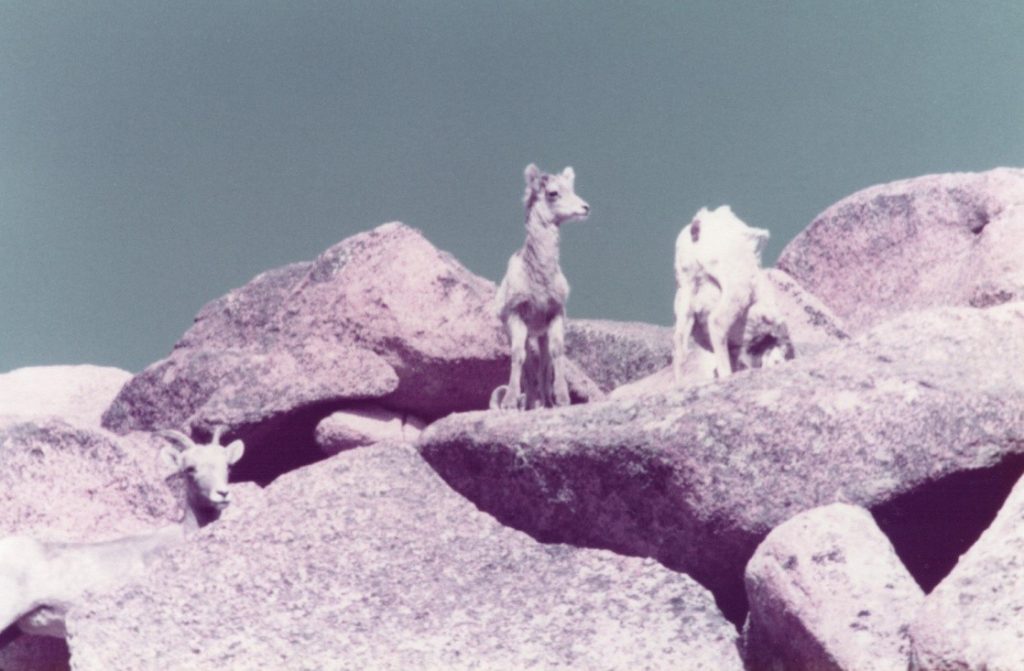
I finally saw three sheep among some large boulders and quickly got a snapshot photo of them. Unfortunately, my plan did not work. Before I could get a shot at one of the ewes, they saw us and spooked. We could see six ewes and lambs as they ran full speed down the mountain for about a half mile before they stopped and looked back up at us. So much for that stalk. All I got was a photo of one ewe from the front, one from the rear and a lamb.
We went back to my truck and decided to hunt down the Ws (switchbacks), stopping frequently to glass the area on both sides of the road but on the left which was a vast hillside of tundra. By the time we got down to the bottom of the Ws without seeing any more sheep, it was getting late, so I decided I had enough hunting for that weekend. So, we went home and made plans for hunting the next weekend.
On the second Saturday of my 1985 ewe hunt season, my partner and I got to the toll gate when it opened shortly after daybreak. Once we got to the bottom of the switchbacks where we had stopped our hunt the previous Sunday, we began stopping at the switchbacks and glassed for sheep.
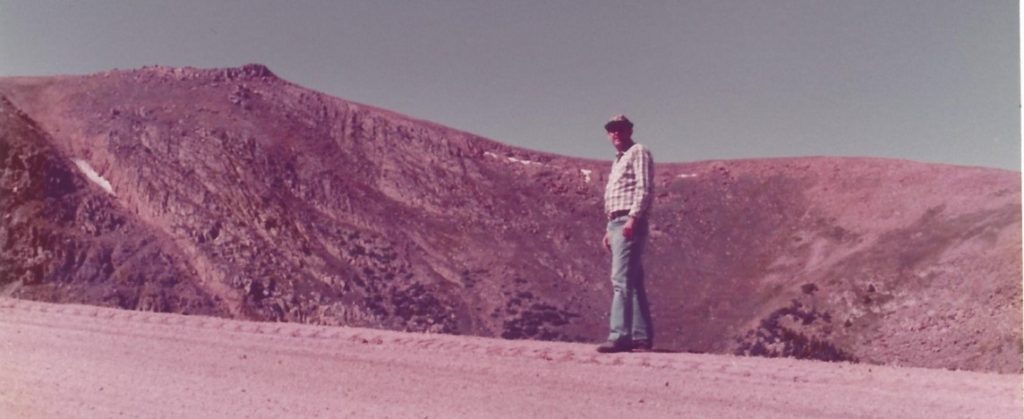
About three switchbacks from the top of the Ws, we stopped to glass the area and took the photo of me with the tundra covered hillside in the background. At this time, we did not see any sheep
Finally at the last switchback before we got to the top of the Ws, I observed five white spots about one mile away on the hillside on the west side of the road. They were located about where my elbow is on the previous photo. Using my spotting scope, I determined that the spots were in fact one lamb and four adults possibly including one young ram. There were possibly up to three legal ewes and I decided to stalk them.
Checking the lay of the land, I decided that the best way to stalk them was to park my truck on top of the Ws near where we had camped the previous weekend. We walked on the top of the ridge but out of sight of the sheep until we were about four hundred yards directly above the sheep. From there I could see a rock outcropping about 200 yards from the sheep from which I could get a good open shot. From the ridge I could also see a route that we could take to drag out the potential kill to the Pikes Peak Highway a short distance above the Mid Point Rest Area. We then slowly descended the hill to the rock outcropping. Since there was no cover between us and the sheep until we got to the outcropping, we had to not make any lateral movement which the sheep could see.
We finally got to the cover provided by the rocks. At that time, we used our binoculars to get a good look at the sheep. We determined which one of the ewes was the mother of the lamb, so I did not want to kill her. There also was one young ram who looked similar to a ewe and I definitely did not want to kill him. Therefore, my goal was to kill one of the two other ewes. Since the sheep were very close together and moved around a bit as they grazed, I had difficulty picking out one of the two eligible ewes using my rifle scope.
I did not want to take a chance and accidentally kill the wrong sheep. Wanting to be 100% sure, I decided that I needed my spotting scope which we had unfortunately left in my truck. I then asked my partner to go back to the truck to get the spotting scope. I cautioned him to be especially careful moving up the hill to the ridgeline behind us and then coming back that same route as we had come down earlier. It took him about 30 minutes to get the scope. I realized that the sheep might decide to leave the area during that delay, but I was willing to take that chance In order to kill the correct sheep.
Once my partner returned with the spotting scope, we took a very close look at all of the sheep. We were able to isolate the two eligible ewes and decide which of the two had the better horns. At that point I got myself into a particularly good prone position, took careful aim, slowly squeezed the trigger and my 180 grain Nossler Partition bullet again did its job. At that time, I thought that my quest for the Pair from the Peak was over. I just had to get the ewe off the mountain and have it mounted. That should have been the easy part of the process, but, as I will describe later, getting it mounted was the hardest part.
I field dressed the ewe and we dragged her down the side of the mountain toward the highway being careful to keep the top part of her body off the ground to protect the cape. Whenever we could see cars on the highway, we set her and my rifle on the ground and sat in front of them so that they were not visible from the road. When we got about 50 yards from the road, we hid the ewe and my rifle behind a small bush. I stayed with them while my partner hitch hiked a ride uphill to where my truck was parked on top of the Ws. When he came back with my truck, we checked the traffic and as soon as we found an opening, we picked up the ewe and my rifle and quickly loaded them on my pickup without being seen by travelers on the road.
We then drove to the Colorado DOW office for the mandatory check of my ewe. After that we went to my home in Colorado Springs where we skinned and caped her. That evening I took the cape and head to a taxidermist whom I knew in Colorado Springs to have her shoulder mounted. Unfortunately, I did not follow the advice of my Ram Hunt guide, Dan: “use a quality taxidermist experienced with mounting sheep”.
About four months later, I got word from the taxidermist that the Ewe mount was ready. Was I in for a surprise.
I walked into his workshop and immediately saw a mounted monster on the wall.
The horns looked like they were mine, but the rest of the head did not look like a Rocky Mountain Bighorn Sheep ewe. I told the taxidermist that I would not hang that monstrosity in my home with the rest of my beautiful mounts. Although he did not explain what went wrong, I believe that he accidentally may have switched my ewe cape with the cape from a ram and tried to mount it on a form for a ewe. Of course, the cape was too big, so he had to use some sort of filler to fill in the void. In any case, the cape was ruined.
The taxidermist told me that he would find another ewe cape and use it to mount my horns. He and I knew that ewe capes were very scarce. He told me that he would apply for a ewe license next year and, if successful, use the cape to mount my ewe horns. Other than get another ewe license myself In the future, I had no other choice but to trust him to get another cape.
In 1984 I applied for another ewe license and got drawn again. Even though I hunted hard every weekend of the season, I did not fill my ewe tag that year. The taxidermist told me that he did not fill his tag either. As it turned out, the taxidermist was not telling the truth. He did not even apply for the license.
I applied for a ewe license again in 1985 and got drawn. On opening day, my partner and I were at the Pikes Peak toll gate when it opened. Shortly after we passed the Mid Point Rest Stop we began glassing both sides of the highway for sheep. We did not see any sheep on the right side of the road where I had killed my ewe two years earlier. However, we finally saw a group of about 8 sheep on the left side, north facing slope. They were in a fairly large level park like area, quite unusual for the mountainous terrain we were in.
I checked my Pike National Forrest map of the area and found a fairly level hiking trail that passed through the area where the sheep were feeding.. The trail head and parking lot were located about 1/2 mile down the highway from our position. I knew that it was more or less impossible to retrieve the ewe directly up to our location on the highway because of the steep drop-off from the highway. I determined that it would be relatively easy to carry her out to the trailhead where we could park my truck. There was enough room between the highway and the drop-off so that I could legally shoot her without being accused of hunting from the road. I could also see a way I could go down the steep hill to the area where the sheep were located. Considering all these factors, I decided to take the 250 yard shot from our location. I used my spotting scope to confirm which ewe was probably barren.
I got myself a good rest, got the ewe I wanted into my scope, and gently squeezed the trigger. Again the 180 grain Nossler Partition bullet did its job.
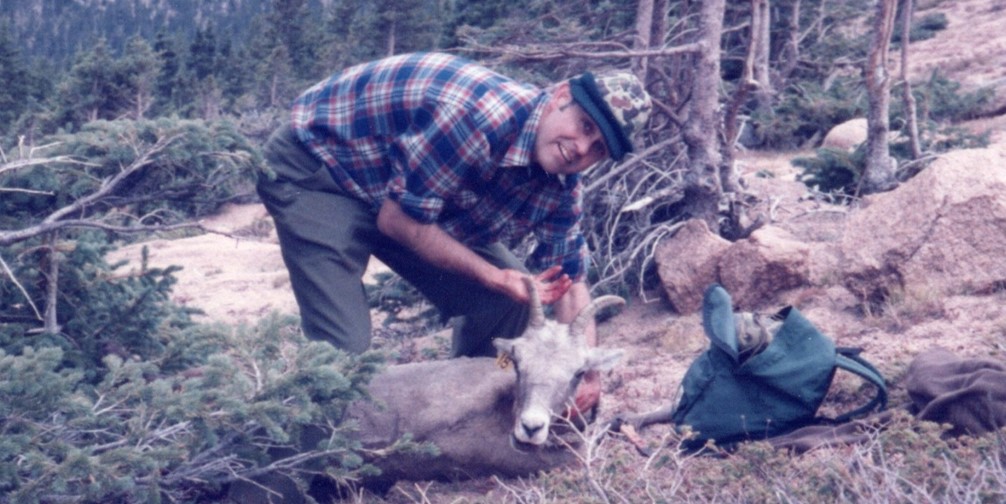
My partner then drove my truck to the trailhead parking lot while I descended the steep slope to the place where my dead ewe was laying. While he was gone, I field dressed the ewe and dragged her to the trail.
A few minutes later, my partner arrived at our location on the trail. Using a small folding saw, we cut down a young aspen tree, tied the ewe’s feet to the pole, and carried her to my truck. This was the only time I ever used this method to transport a kill out of the woods. It certainly protected the cape from damage which could have occurred if we would have dragged her out. Of course, without my partner I could not have done this.
By 2 PM we were at the Colorado DOW office for the mandatory check of my ewe. After that we went to my home in Colorado Springs where we skinned and caped her. That evening I took the cape and head to the owner of the taxidermy shop to have her shoulder mounted. I had already decided to use the owner himself, who was experienced with mounting sheep, to mount my ewe rather than his partner who ruined my previous cape. The owner told me that his former business partner had skipped town, along with my deposit.
The owner taxidermist apologized for the poor service I had gotten from his former partner. To try to make amends, he offered to mount my ewe for free, using the horns from my 1983 kill and the cape from my ewe I had just killed in 1985. He would work on my mount as he got time but it might take him a long time to complete.
Almost one year later, in 1986, the taxidermist called me and told me that my ewe mount was ready. It was worth the wait. My “Pair from the Peak” was now a reality.
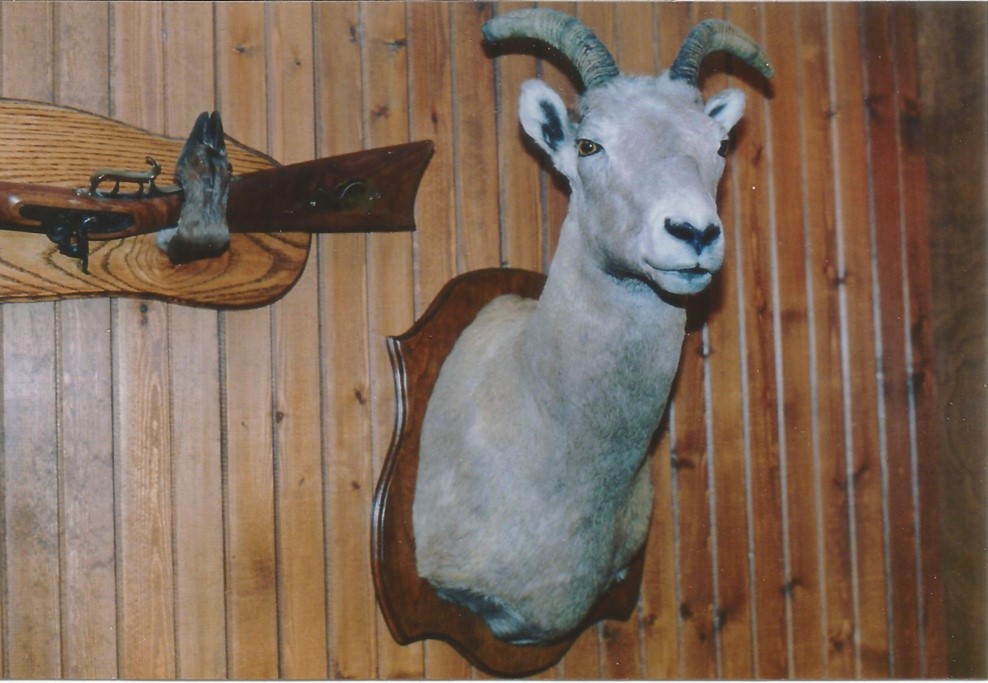
I proudly hung her on the wall in my trophy room, next to my ram. Very few hunters are able to put up such a display. By the same token, very few had the adventure of hunting them as I had experienced.
Comparing the ewe from the 1985 season in the previous photo with the trophy hanging on my wall in 1986, you will see that the horns on the mounted ewe are considerably wider than the ewe in the 1985 photo. The taxidermist did a great job of using the horns from my 1983 ewe and the cape from my 1985 ewe to come up with the beautiful mount I now have. Three years after the incompetent taxidermist ruined my mount in 1983, his partner rectified the situation with a mount I can be proud of. Unfortunately, I don’t recall the name of the taxidermist who did me this wonderful favor at his expense but I am grateful for his generosity.
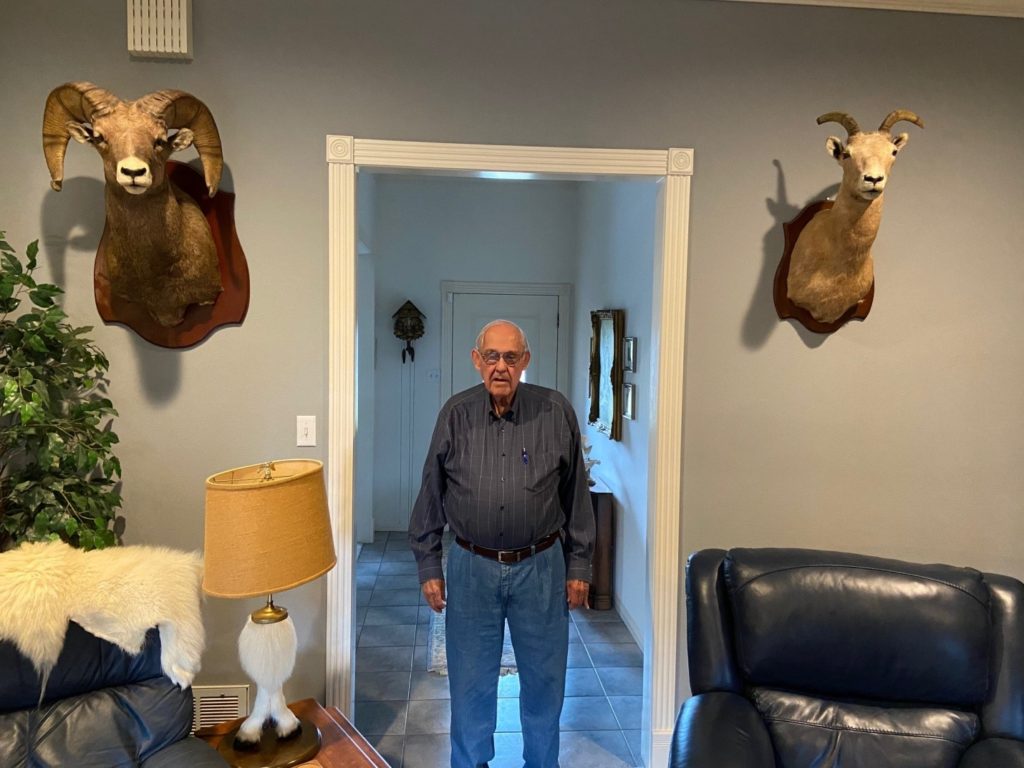
Today, in 2021, my Pikes Peak Pair hang in my living room in New Braunfels, Texas, on the opposite wall from my Royal Bull Elk. Here I can relive my adventures I had hunting Rocky Mountain Bighorn Sheep on Pikes Peak in Beautiful Colorado
I am certainly indebted to my friends who partnered with me on my hunting trips to hunt for my ewes on Pikes Peak. Unfortunately, I only remember one of their names–Gary Goeckerman. Thanks, Gary and the rest of you. I know that you enjoyed the delicious meat from the ewes I shared with you. Thanks also to my guide, Dan Aubuchon, for guiding me on my Ram hunt. Without help from all of you, I could not have completed my Pair from the Peak.
Clarence Scheel
Latest posts by Clarence Scheel (see all)
- HUNTING REHBOCK (ROEBUCK) IN GERMANY – September 27, 2022
- HUNTING FALLOW DEER (DAMHIRSCH) IN GERMANY – September 23, 2022
- HUNTING ROCKY MOUNTAIN GOAT NEAR BUENA VISTA, COLORADO – October 10, 2021
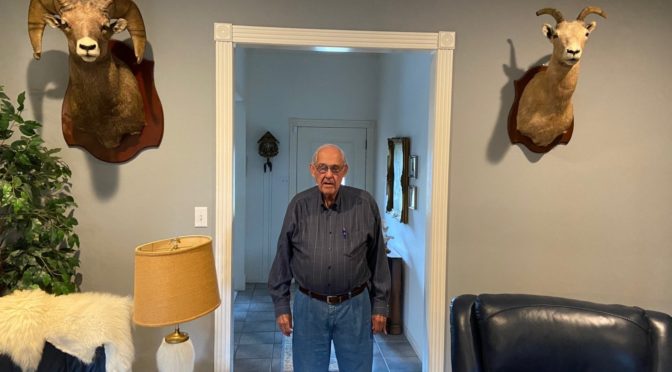
Leave a Reply